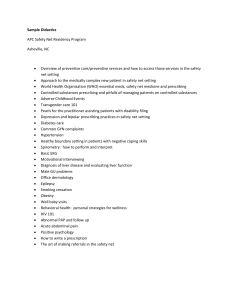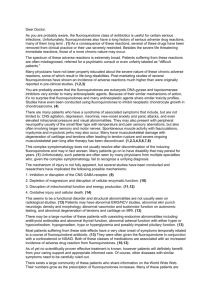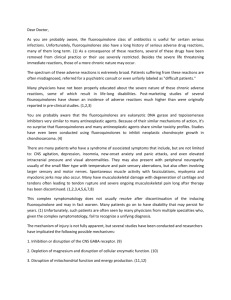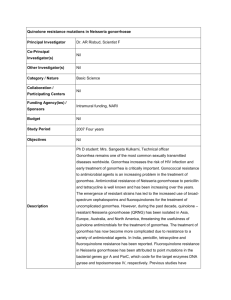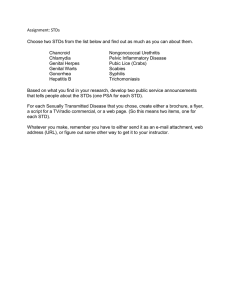Prescribing changes following revised treatment guidelines for gonorrhea April 30, 2010
advertisement
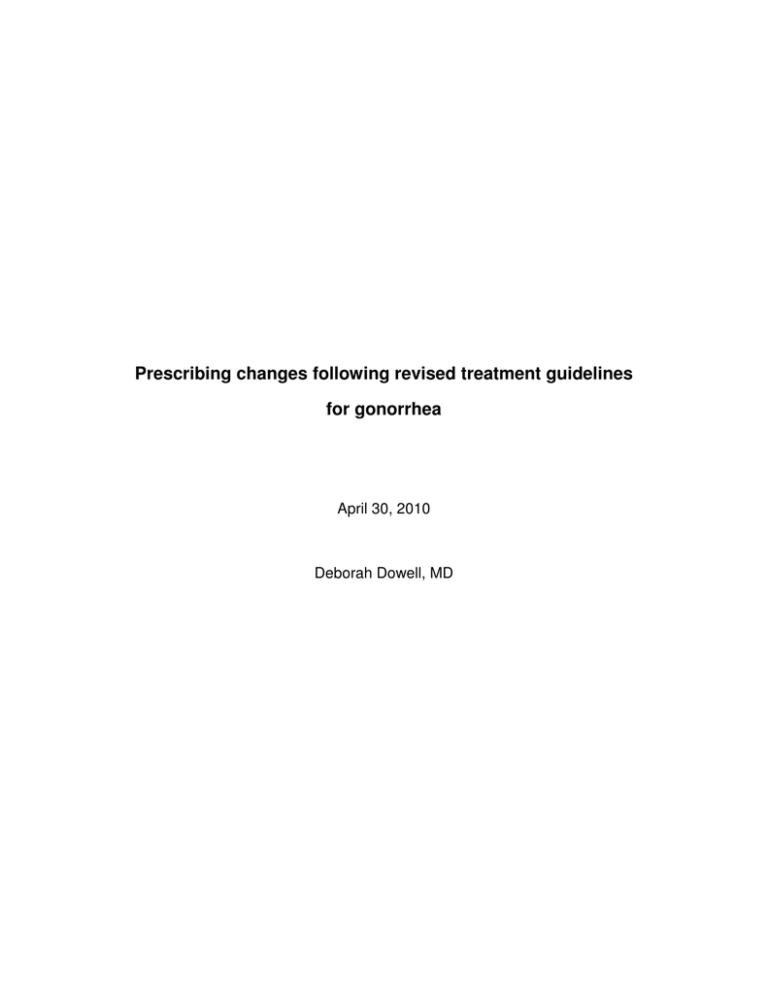
Prescribing changes following revised treatment guidelines for gonorrhea April 30, 2010 Deborah Dowell, MD Executive Summary Context In April 2007, increasing resistance to fluoroquinolone antimicrobials among Neisseria gonorrhoeae prompted the Centers for Disease Control and Prevention to stop recommending fluoroquinolones for treatment of gonorrhea, the second most common notifiable disease in the United States. This revised recommendation was published in MMWR and received extensive media attention. Objective Evaluate the impact of revised national treatment recommendations on fluoroquinolone use for gonorrhea overall, by area, and by practice setting. Design and Setting Interrupted Time Series Analysis of notifiable case report data from 20 two-week intervals before and 30 two-week intervals after revised national prescribing recommendations were released. Patients Gonorrhea cases reported by five local or state health departments participating in the STD Surveillance Network (SSuN) from metropolitan areas (Denver, CO, Minneapolis, MN, Richmond, VA, Baltimore, MD, Hartford and New Haven, CT) within their jurisdictions. All cases reported with treatment date from July 1, 2006 to May 31, 2008 were evaluated. Results Among 16,126 cases, 15,669 (97.2%) included medication used. Of 13,846 reported with practice setting information, most were reported from STD clinics (34.6%), primary care (25.8%), emergency room or urgent care (16.0%) or hospitals (12.1%). After revised guidelines were released, fluoroquinolone use decreased, following an abrupt and permanent pattern overall (21.5%; 95% CI, 15.9%-27.2%), in Colorado (48.3%; 95% CI, 42.0%-54.6%), Minnesota (10.9%; 95% CI, 7.4%-14.5%), Virginia (28.2%; 95% CI, 18.3%-38.2%), Baltimore (7.9%; 95% CI, 3.9% increase-19.8% decrease), and among STD clinic providers (28.5%; 95% CI, 19.0%-37.9%). Decreases followed a gradual and permanent pattern in Connecticut 8.5 % (95% CI, -11.9,-5.1), among primary care providers (8.6%; 95% CI, 2.6%-14.6%), and among emergency room/urgent care/hospital providers (2.7%; 95% CI, 1.7%-3.7%). Conclusions Fluoroquinolone use decreased following release of revised national guidelines, particularly among STD clinic providers. Additional mechanisms to influence prescribing among primary care, emergency room, and hospital providers are needed. 1 Neisseria gonorrhoeae are estimated to infect more than 700,000 people a year in the United States.1 In 2008, 112 cases/100,000 population were reported,2 well above the Healthy People 2010 target of 19 cases per 100,000 population.3 Gonorrhea rates have remained high among African-Americans, adolescents, and men who have sex with men, and in the Southeastern United States.4 Infection can cause pelvic inflammatory disease with long-term consequences including ectopic pregnancy, infertility, and chronic pelvic pain, and may increase HIV transmission.5 Effective treatment is critical both to prevent sequelae in affected patients and to prevent the spread of infection to others. Treatment has been challenging because of increased frequency of Neisseria gonorrhoeae which are resistant to multiple classes of antimicrobials, including sulfanilamides, penicillin, tetracyclines, and fluoroquinolones.6,7 During the 1990s, use of broad-spectrum antimicrobials, including fluoroquinolones, increased in the United States from 24% to 48% of antibiotic courses prescribed, even as overall antimicrobial use decreased.8 Fluoroquinolones have been used widely for treatment of gonorrhea since the 1990s.9 In 2002, fluoroquinolones became the most commonly used class of antimicrobials in the United States, and in that year were prescribed at 22 million office visits.10 Broad-spectrum antimicrobials increase antimicrobial resistance from selective pressure on different groups of microbial flora and contribute to the spread of resistance to antimicrobials used for multiple infections. Resistance to fluoroquinolones thought to be related to increased use has emerged among a variety of infectious organisms, including Streptococcus pneumoniae,11,12 Klebsiella pneumoniae,13 Pseudomonas aeruginosa,14 Salmonella enterica,15, Escherichia coli,16 and Neisseria meningitides,17 in addition to Neisseria gonorrhoeae.18 Because of increasing resistance to the fluoroquinolone ciprofloxacin among Neisseria gonorrhoeae in the Gonococcal Isolate Surveillance Project (GISP) from 3.8% in 2005 to 6.7% in the first 6 months of 2007, the Centers for Disease Control and Prevention (CDC) removed fluoroquinolones from drugs recommended for treatment of gonorrhea.17 Fluoroquinolones had already been removed from recommended treatments for gonorrhea in Hawaii,19 California,20 and for men who have sex with men21 because of increased rates of fluoroquinolone-resistant Neisseria gonorrhoeae in those populations. Cephalosporins are now the only class of antimicrobials available in the United States that includes recommended therapies for gonorrhea. Revised CDC guidelines removing fluoroquinolones from recommended treatments for gonorrhea were published in Morbidity and Mortality Weekly Reports (MMWR) on April 13, 2007,17 updated CDC’s STD Treatment Guidelines, were sent to state and local health departments in a Dear Colleague letter, and were announced at a press conference timed to correspond with the 2 MMWR article. This announcement received extensive media attention.22,23,24,25,26 It is not known how providers responded to the revised recommendations. To evaluate prescribing for gonorrhea before and after treatment recommendations changed, we used data from the Sexually Transmitted Diseases (STD) Surveillance Network (SSuN). We employed interrupted timeseries analysis to evaluate the impact of revised guidelines on fluoroquinolone use and to determine if impact varied by geographic area or by practice setting. METHODS Study Design, Data Sources and Identification of Patients Health providers and laboratories in the United States are legally mandated to report gonorrhea cases to local health departments.27 Health departments participating in the STD Surveillance Network (SSuN), a national surveillance network comprised of local health departments conducting enhanced STD surveillance following common protocols, contribute case report information, including treatment used and treatment date, for all gonorrhea cases reported in selected jurisdictions, to the SSuN dataset. For this analysis, five collaborating health departments participating in SSuN contributed data from the following jurisdictions: the Colorado Department of Public Health and Environment (Adams, Arapaho, and Denver Counties including the Denver 3 metropolitan area), the Minnesota Department of Health (Hennepin County including Minneapolis), the Virginia Department of Health (Richmond City and Chesterfield and Henrico Counties, including the Richmond metropolitan area), the Baltimore City Health Department (Baltimore, Maryland), and the Connecticut Department of Public Health (Hartford and New Haven counties, including the Hartford and New Haven metropolitan areas). SSuN sites in geographic areas for which CDC had previously recommended fluoroquinolones not be prescribed20 or for which local health departments had previously issued recommendations against fluoroquinolone use in their jurisdictions28,29,30 were not included. In order to determine the effect of revised recommendations on the proportion of gonorrhea cases prescribed fluoroquinolones, we reviewed all gonorrhea cases reported from these sites with a treatment date from July 1, 2006 to May 31, 2008. Cases were excluded if they were missing medication used, or if they were recorded as not treated. Cases were excluded from analysis by practice setting if they were missing practice setting information. Study Outcomes The primary outcome was absolute change in percentage of gonorrhea cases treated with fluoroquinolones after revised guidelines removed fluoroquinolones from recommended treatments for gonorrhea. Prescribing changes were determined for proportion of cases prescribed fluoroquinolones 4 overall, by geographic area, and by practice setting. The study period was divided into 50 14-day intervals (20 intervals before and 30 intervals after revised guidelines were released at the 21st interval on April 13, 2007). The percentage of cases treated with fluoroquinolones among all cases treated with antimicrobials was determined for each 14-day interval. Cases were considered to have been treated with a fluoroquinolone if ciprofloxacin, levofloxacin, ofloxacin, gatifloxicin, norfloxacin, lomefloxacin, or gemifloxacin was prescribed. Cases treated with both a fluoroquinolone and a recommended treatment for gonorrhea (ceftriaxone or cefixime) were counted as not treated with a fluoroquinolone. Each general geographic area and the most common practice settings were evaluated for changes in prescribing after revised guidelines were released. Because of a relatively small number of cases reported from emergency rooms, urgent care settings, and hospitals, cases from these practice settings were combined into one category. Statistical Analysis We used autoregressive integrated moving average (ARIMA) interrupted time series analysis techniques31,32 to determine the effect of revised recommendations on fluoroquinolone prescribing for gonorrhea. The details of ARIMA time series analysis can be found elsewhere.32, 33 Briefly, ARIMA interrupted time series analysis is a quasi-experimental approach for evaluating longitudinal effects of an intervention. It has two components, an ARIMA noise 5 component ( ) and an intervention component ( is the outcome at time t. )); , where, accounts for the possible sources of noise that time series data may have; once the sources of noise are modeled, the impact of an intervention can be determined by testing a selected intervention component. A three-stage approach including model identification, model estimation, and model evaluation was used to obtain an adequate ARIMA component model. The estimated parameters of the ARIMA component that were statistically significant and satisfied the condition of stationarity-invertability were selected. The model residuals were evaluated by residual autocorrelation function plot and the LjungBox Q–test34 up to 24 interval lags. The residuals of all ARIMA models reported here corresponded to white noise. We assumed that the impact of revised recommendations followed either an abrupt and permanent pattern or a gradual and permanent pattern. Each of these two intervention patterns was modeled for all outcome time series, and the pattern with better fit was selected for each series. For gradual and permanent patterns, shift rates ( ) ranging from 0 to 1 were determined, with higher values indicating a longer time before full realization of an effect. The SAS-ARIMA procedure with maximum likelihood estimation was used to construct the models.35,36 All statistical analyses were performed using SAS 9.1 for Windows (SAS institute Inc., Cary, North Carolina) and SPSS version 17 (SPSS, Inc., Chicago Illinois). P values < 0.05 were considered to be statistically significant. All statistical tests were two-tailed. 6 Human Subjects As a disease control and surveillance activity, SSuN was determined by CDC to be a nonresearch, public health activity. RESULTS Fluoroquinolone prescribing overall 16,126 cases were reported as treated between July 1, 2006 and May 31, 2008. Of these, 457 cases (2.8%) did not include treatment used and were excluded, leaving 15,669 cases in the analysis (TABLE 1). Interrupted time series analysis found prescribing changes consistent with an abrupt and permanent pattern for effect of revised guidelines (TABLE 2). The proportion of gonorrhea cases treated with fluoroquinolones decreased 21.5% (95% confidence interval (CI), 15.9%, 27.2%) after revised guidelines were released (FIGURE 1A). Fluoroquinolone prescribing by geographic area In Denver, Minneapolis, Richmond, and Baltimore, interrupted time series analyses found prescribing changes consistent with an abrupt and permanent pattern for effect of revised guidelines (FIGURE 1B-E, TABLE 2). Following the release of revised guidelines, proportion of gonorrhea cases treated with fluoroquinolones decreased 48.3% in Denver (95% CI, 42.0% - 54.6%), 10.9 % 7 in Minneapolis (95% CI, 7.4% -14.55%), 7.9% in Baltimore (95% CI, 19.8% decrease - 3.9% increase), and 28.2% in Richmond (95% CI, 18.3% - 38.2%). In Connecticut (FIGURE 1F), prescribing changes were consistent with a gradual and permanent pattern for effect of revised guidelines (TABLE 2); proportion of cases treated with fluoroquinolones decreased 8.5% (95% CI, 5.1%, - 11.9%) by two weeks following the release of revised guidelines, then decreased at a gradual shift rate of 0.72. Fluoroquinolone prescribing by practice setting 13,846 of the 15,669 cases with treatment information in the overall analysis (88.4%) included information on practice setting (TABLE 3). Of these, 4,785 (34.6%) were treated in an STD clinic, 3,577 (25.8%) in primary care, 2,219 (16.0%) in an emergency room or urgent care setting, and 1,673 in a hospital (12.1%). Prescribing changes in STD clinics were consistent with an abrupt and permanent pattern for effect of revised guidelines (TABLE 2, FIGURE 2A). The proportion of gonorrhea cases treated with fluoroquinolones decreased 28.5% (95% CI, 19.0% - 37.9%) after revised guidelines were released (FIGURE 2A). Monthly proportions of cases prescribed fluoroquinolones in STD clinics in different areas (FIGURE 3A-E) showed different patterns. While fluoroquinolone prescribing in STD clinics in 4 of the 5 areas was close to zero by 2008, a 8 majority of STD clinic cases in Minneapolis continued to receive fluoroquinolones. Fluoroquinolone prescribing in STD clinics in Denver and Richmond showed prompt and sustained reduction. STD clinics in Baltimore also decreased fluoroquinolone prescribing substantially, but did so 6 months after national treatment recommendations changed. In Connecticut STD clinics, fluoroquinolone prescribing was already infrequent and remained so after recommendations changed. For patients seen in primary care and those seen in emergency rooms, urgent care, and hospitals, prescribing changes were most consistent with a gradual and permanent pattern for effect of revised guidelines (TABLE 2, FIGURE 2B-C). At two weeks after the release of revised national treatment guidelines, proportion of cases treated with fluoroquinolones decreased 8.6% (95% CI, 2.6%-14.6%) in primary care and 2.7% (95% CI, 1.7%-3.7%) in emergency rooms, urgent care, and hospitals, then decreased at gradual shift rates of 0.62 for primary care and 0.90 for emergency rooms, urgent care, and hospitals. DISCUSSION We used SSuN, a sentinel surveillance system containing enhanced data, including treatment information, on all nationally reported gonorrhea cases from selected jurisdictions, to evaluate the effect of revised national guidelines for 9 treatment of gonorrhea. We found fluoroquinolone use decreased significantly after publication and dissemination of revised national guidelines removing fluoroquinolones from recommended treatments for gonorrhea. Fluoroquinolone prescribing decreased significantly and by large magnitudes in Denver and Richmond, decreased significantly but by a smaller magnitude in Hartford, New Haven, and Minneapolis, and did not decrease significantly relative to release of revised guidelines in Baltimore. Fluoroquinolone prescribing decreased significantly in all practice settings but more quickly and by a greater magnitude in STD clinics. Although the Interagency Task Force on Antimicrobial Resistance, co-chaired by the CDC, the Food and Drug Administration, and the National Institutes of Health, recommends monitoring of antimicrobial use as a “Top Priority Action Item to Combat Antimicrobial Resistance,”37 there are limited data available on antibiotic prescribing for infections with potential for increased antibiotic resistance, including Neisseria gonorrhoeae. These findings add to our understanding of how providers respond to guidelines by providing estimates of prescribing for reported gonorrhea cases among different provider specialties in selected areas of the United States. Several factors may explain differences in fluoroquinolone use by practice setting. Providers in STD clinics commonly follow protocols and may prescribe medications from a set formulary. Changes made by STD clinic directors could therefore have a larger, more coordinated impact than changes made by 10 individual clinicians in more generalist settings. In addition, STD clinics tend to receive federal, state, or county funding, which gives them a direct relationship with governmental health departments and additional sources of communication regarding revised treatment guidelines. Differences in fluoroquinolone use by area may be partly explained by local health department communications to providers. We reviewed local and state health department communications regarding fluoroquinolones for the areas and time periods studied. There were no specific interventions by the state of Colorado, but there was a change of prescribing policy in Denver’s STD clinic, and updates were sent to all providers in Denver Health, the largest provider for inner-city Denver. The Virginia Department of Health mailed an article about CDC’s revised guidelines to local Health Departments and to each licensed physician in the state in May 2007. Because local resistance rates among heterosexuals were low, the Minnesota Department of Health, (MDH) on September 25, 2007 recommended “the continued cautious use of [fluoroquinolones] for … gonorrhea in heterosexuals.”38 MDH subsequently reevaluated fluoroquinolone resistance to Neisseria gonorrhea among heterosexuals in Minnesota, found resistance had increased from 0.8% in 2006 to 4.5% by December 2007, and released a Dear Colleague letter on June 4, 2008 stating fluoroquinolones were no longer recommended for gonorrhea treatment in Minnesota.39 Our analysis does not cover the time period following 11 this 2008 announcement. Our findings suggest that local communications may have amplified or moderated national messages about fluoroquinolone prescribing. A significant decrease in fluoroquinolone prescribing in Baltimore was not detected by interrupted time series analysis, most likely because the substantial local decreases in fluoroquinolone prescribing followed the release of revised guidelines by several months and therefore cannot be attributed to this intervention. Evaluation of prescribing over time by practice setting in Baltimore shows that the later decreases in fluoroquinolone use were driven primarily by changes in STD clinics (Figure 3D). It is possible that STD clinics waited for stocks of formulary medications to diminish before making a change to prescribe medications other than fluoroquinolones for gonorrhea. The more gradual impact of revised treatment recommendations in Connecticut may reflect that STD clinic providers were already prescribing fluoroquinolones at a low frequency (FIGURE 3E), so most of the observed change in this area was driven by providers in more general practice settings. Our analysis is subject to several limitations. We could not rule out impact of events concurrent with the release of national guidelines. Still, interrupted time series analysis is “a robust method of measuring the effect of an intervention when randomization or identification of a control group are impractical (e.g. 12 change in policy),”40 and the rapidity of decreases in fluoroquinolone use overall and in many areas after release of revised guidelines supports the conclusion that prescribing changes were related to this intervention. While we were able to stratify by practice setting given enhanced data in SSuN, which has more complete provider data than does routine case reporting, the provider data in SSuN still consist of crude categories, and it is difficult to standardize across sites (e.g. medicine clinics in hospitals might be recorded as “hospital” at one site and “primary care” at another). In addition, several practice settings (e.g. family planning, prisons) could not be examined due to relatively low numbers of cases. Because cases were selected by treatment date, cases missing treatment date were not included. Selecting cases by treatment date was necessary in order to classify cases into the appropriate time interval in relationship to the intervention. Excluding cases without treatment date (as well as all unreported cases) may have overestimated adherence to guidelines as there may be correlation between providers who report more complete information and who are aware of and follow treatment recommendations. Whether changes in prescribing were related to awareness of guidelines, perceptions of the importance of following guidelines, or other factors is unknown. The importance of various factors might be best understood though surveys of providers’ knowledge and attitudes. Finally, our sample cannot be considered to be nationally representative. However, the sites were in 5 geographically diverse areas, and cases reported 13 within the selected jurisdictions provided a comprehensive picture of gonorrhea morbidity reported to public health departments. One definition of appropriate prescribing of antimicrobials, from the CDC, is prescription of antimicrobial agents only when they are likely to be beneficial to the patient, and using agents that target the likely pathogens at the proper dose and duration.41 Based on data from the National Ambulatory Medical Care Survey (NAMCS), more than 40% of antimicrobial prescriptions provided in physician offices in 1992 were inappropriate.42 Multiple methods to decrease inappropriate prescribing including prescribing restrictions, reminders, printed materials, and feedback have been evaluated, but it has been unclear which elements are most effective in influencing antimicrobial prescribing.43,44 Our results demonstrate that widely disseminated national recommendations can impact prescribing behavior and suggest that local public health messages can modify their impact. Additional mechanisms may be needed to encourage appropriate antimicrobial prescribing among primary care, emergency room, and hospital providers. Because greater impact was seen in STD clinics, where set formularies are often used, mechanisms to influence prescribing in other settings might include managed care and hospital formulary changes. Monitoring for antimicrobial resistance to Neisseria gonorrhoeae continues to be critical as treatments with established efficacy are increasingly 14 limited. Prompt changes in prescribing practices may become even more critical if resistance emerges to cephalosporins, the single remaining recommended class of antibiotics for gonorrhea treatment. 15 Acknowledgements The STD Surveillance Network (SSuN) is funded by the CDC (grant numbers AA055, PS08-865) an agency of the United States Department of Health and Human Services. The author thanks the following individuals for their contributions to this project: Lin H. Tian, MD, MS,1 participated in analysis of data, contributed to drafting the Statistical Analysis subsection of the Methods Section and Table 2, and reviewed the manuscript for accuracy regarding Interrupted Time Series Analysis methodology and results. Jeffrey A. Stover, MPH, 2 Jennifer A. Donnelly, BS,3 Summer Martins, MPH,4 Emily J. Erbelding, MD, MPH,5 Katherine Harrison, MPH5 and Raul Pino, MD,6 provided and verified data and provided information about local public health communications. Hillard Weinstock, MD, MPH, 1 and Lori M. Newman, MD1 provided SSuN project support. Darlene Davis1 provided SSuN data management support. 1 2 Centers for Disease Control and Prevention, Division of STD Prevention, Atlanta, GA Virginia 3 Department of Health, Division of Disease Prevention, Richmond, VA Colorado Department of 4 Public Health and Environment, Denver, CO Minnesota Department of Health, STD and HIV 5 6 Section, St. Paul, MN Baltimore City Health Department, Baltimore, MD Connecticut Department of Public Health, Hartford, CT 16 Table 1. Number of gonorrhea cases with reported treatment dates July 1, 2006-May 31, 2008 Denver Medication recorded Recorded as not treated Recorded as treated with unknown medication Total reported cases Hartford/New Haven Minneapolis Baltimore Richmond Total n % n % n % n % n % n % 2727 94.9% 2944 98.8% 3075 99.8% 4656 99.6% 2267 90.1% 15669 97.2% 51 1.8% 0 0.0% 0 0.0% 11 0.2% 1 0.0% 63 0.4% 96 3.3% 37 1.2% 5 0.2% 7 0.1% 249 9.9% 394 2.4% 2874 100.0% 2981 100.0% 3080 100.0% 4674 100.0% 2517 100.0% 16126 100.0% Table 2. Impact of CDC revised recommendations on percentage of patients with gonorrhea prescribed fluoroquinolones ARIMA Noise Component (p, d, q)4 Pattern of impact from intervention (revised guidelines)1 Abrupt and Permanent Impact2 , % (95% CI) Area Overall Denver Minneapolis, MN Richmond, VA Baltimore, MD Hartford and New Haven, CT (2, 1, 0) (0, 0, 1) (0, 0, 0) (0, 1, 1) (0, 1, 1) (0, 0, 0) -21.5 (-27.2,-15.9) 5 -48.3 (-54.6,-42.0) 5 -10.9 (-14.5, -7.4) 5 -28.2 (-38.2,-18.3) 5 -7.9 (-19.8, +3.9) Practice Setting STD clinic Primary care Emergency room, urgent care, hospital (0, 1, 1) (0, 1, 1) (0, 0, 0) -28.5 (-37.9,-19.0) 5 Gradual and Permanent Impact3 , % (95% CI) , shift rate (95% CI) -8.5 (-11.9,-5.1) 5 0.72 (0.61,0.84) 5 -8.6 (-14.6,-2.6) 5 -2.7 (-3.7,-1.7) 5 0.62 (0.35,0.89) 5 0.90 (0.85,0.95) 5 1 For each area or practice setting, results are shown for the modeled pattern of impact that better fit the time series data 2 For abrupt and permanent impact, the intervention component is represented by the equation , where is the parameter of the intervention variable estimated to represent the difference in proportion of patients prescribed fluoroquinolones before and after the revised guidelines were released . 3 For gradual and permanent impact, the intervention component is represented by the equation proportion of patients prescribed fluoroquinolones at the interval when revised guidelines were released; , where is the difference in provides the shift rate (ranges from 0 to 1, with higher values indicating a longer time before an effect is fully realized); is the backshift operator such that . 4 the ARIMA model includes three processes: autoregressive, differencing, and moving average; p, d, and q represent the orders of the structures for each of these processes. 5 p-value <0.05 18 Table 3. Number of cases by practice setting Denver Practice setting STD clinic Minneapolis 1 n 1058 38.8% n % Hartford/New Haven 1 n 876 30.5% % Baltimore 1 n 424 20.4% % Richmond 1 n 1455 37.3% % Total 1 n 972 42.9% 4785 34.6% % % 1 Primary care Emergency room/ Urgent care 641 23.5% 944 32.9% 672 32.3% 694 17.8% 626 27.6% 3577 25.8% 180 6.6% 657 22.9% 530 25.5% 308 7.9% 544 24.0% 2219 16.0% Hospital 439 16.1% 0 0.0% 1 0.0% 1228 31.5% 5 0.2% 1673 12.1% Family planning 144 5.3% 182 6.3% 345 16.6% 219 5.6% 69 3.0% 959 6.9% Jail/Prison 105 3.9% 33 1.1% 51 2.5% 0 0.0% 12 0.5% 201 1.5% HIV care center 12 0.4% 3 0.1% 29 1.4% 0 0.0% 1 0.0% 45 0.3% Prenatal 84 3.1% 0 0.0% 21 1.0% 0 0.0% 28 1.2% 133 1.0% School 15 0.6% 37 1.3% 2 0.1% 0 0.0% 0 0.0% 54 0.4% Military 10 0.4% 5 0.2% 0 0.0% 0 0.0% 0 0.0% 15 0.1% Obstetrics/Gynecology 0 0.0% 0 0.0% 0 0.0% 0 0.0% 1 0.0% 1 0.0% Outreach 2 0.1% 0 0.0% 0 0.0% 0 0.0% 0 0.0% 2 0.0% 36 1.3% 135 4.7% 3 0.1% 0 0.0% 8 0.4% 182 1.3% 2726 100.0% 2872 100.0% 2078 100.0% 3904 100.0% 2266 100.0% 13846 100.0% Other Total with practice setting information 1 of those with known practice setting 19 Table 4. Antimicrobials prescribed for gonorrhea, before and after CDC revised treatment recommendations ceftriaxone cefixime1 cefpodoxime other cephalosporin2 ciprofloxacin other fluoroquinolone3 azithromycin other antimicrobial July 1, 2006-April 12, 2007 42.4% 1.1% 2.4% 0.3% 40.5% 10.3% 2.1% 0.9% April 13, 2007-May 31, 2008 69.8% 3.1% 2.2% 0.5% 18.6% 1.8% 2.6% 1.4% 1 cefixime oral tablets were not available in the United States from July 2002 – April 2008. Cefixime oral suspension has been available since February 2004. 2 cefoxitin, cefuroxime, cefotetan, ceftizoxime, or cefazolin 3 ofloxacin, levofloxacin, or moxifloxacin 20 22 23 1 Weinstock H, Berman S, Cates W Jr. Sexually transmitted diseases among American youth: incidence and prevalence estimates, 2000. Perspect Sex Reprod Health. 2004;36:6-10. 2 Centers for Disease Control and Prevention. Sexually Transmitted Disease Surveillance 2008. Atlanta, GA: U.S. Department of Health and Human Services; November 2009. 3 U.S. Department of Health and Human Services. Healthy People 2010: Volume 2. 2nd ed. Washington: DC: Government Printing Office; November 2000. 4 Centers for Disease Control and Prevention. Sexually Transmitted Disease Surveillance, 2007. Atlanta:U.S. Department of Health and Human Services; 2009. 5 Fleming DT, Wasserheit JN. From epidemiologic synergy to public health policy and practice: the contribution of other sexually transmitted diseases to sexual transmission of HIV infection. Sex Transm Infect. 1999;75:3-17. 6 Workowski KA, Berman SM, Douglas JM. Emerging antimicrobial resistance in Neisseria gonorrhoeae: urgent need to strengthen prevention strategies. Ann Intern Med. 2008;148:606-13. 7 Wang SA, Harvey AB, Conner SM, Zaidi AA, Knapp JS, Whittington WLH, et al. Antimicrobial resistance for Neisseria gonorrhoeae in the United States, 1988-2003: the spread of fluoroquinolone resistance. Ann Intern Med. 2007;147:81-8. 8 Steinman MA, Gonzales R, Linder JA, Landefeld CS. Changing use of antibiotics in community-based outpatient practice. Ann Intern Med. 2003;138:525-33. 9 Wang SA, Harvey AB, Conner SM, Zaidi AA, Knapp JS, Whittington WLH, et al. Antimicrobial resistance for Neisseria gonorrhoeae in the United States, 1988-2003: the spread of fluoroquinolone resistance. Ann Intern Med. 2007;147:81-8. 10 Linder JA, Huang ES, Steinman MA, Gonzales R, Stafford RS. Fluoroquinolone prescribing in the United States: 1995 to 2002. Am J Med. 2005;118:259-68. 11 Centers for Disease Control and Prevention. Resistance of Streptococcus pneumoniae to fluoroquinolones— United States, 1995-1999. MMWR Morb Mortal Wkly Rep. 2001;50:800-4. 12 Brueggemann AB, Coffman SL, Rhomberg P, Huynh H, Almer L, Nilius A, et al. Fluoroquinolone resistance in United States since 1994-95. Antimicrob Agents Chemother. 2002;46:680-8. 13 Lautenbach E, Fishman NO, Bilker WB, Castiglioni A, Metlay JP, Edelstein PH, et al. Risk factors for fluoroquinolone resistance in nosocomial Escherichia coli and Klebsiella pneumoniae infections. Arch Intern Med. 2002;162:2469-77. 14 Lautenbach E, Strom BL, Nachamkin I, Bilker WB, Marr AM, Larosa LA et al. Longitudinal trends fluoroquinolone resistance among Enterobacteriaceae isolates from inpatients and outpatients, 1989-2000: differences in the emergence and epidemiology of resistance across organisms. Clin Infect Dis. 2004;38:655-62. 15 Olsen SJ, DeBess EE, McGivern TE, Marano N, Eby T, Mauvais S, et al. A nosocomial outbreak of fluoroquinoloneresistant salmonella infection. N Engl J Med. 2001;344:1572-9. 24 16 Cometta A, Calandra T, Bille J, Glause MP. Escherichia coli resistant to fluoroquinolones in patients with cancer and neutropenia. N Engl J Med. 1994;330:1240-1. 17 Wu HM, Harcourt BH, Hatcher CP, Wei SC, Novak RT, Wang X, et al. Emergence of ciprofloxacin-resistant Neisseria meningitidis in North America. N Engl J Med. 2009;360:886-92. 18 Centers for Disease Control and Prevention. Update to CDC's Sexually Transmitted Diseases Treatment Guidelines, 2006: Fluoroquinolones No Longer Recommended for Treatment of Gonococcal Infections. MMWR Morb Mortal Wkly Rep. 2007; 56: 332-6. 19 Centers for Disease Control and Prevention. Fluoroquinolone-Resistance in Neisseria gonorrhoeae, Hawaii, 1999, and Decreased Susceptibility to Azithromycin in N. gonorrhoeae, Missouri, 1999. MMWR Morb Mortal Wkly Rep. 2000; 49: 833-7. 20 Centers for Disease Control and Prevention. Increases in Fluoroquinolone-Resistant Neisseria gonorrhoeae --Hawaii and California, 2001. . MMWR Morb Mortal Wkly Rep. 2002; 51: 1041-4. 21 Increases in Fluoroquinolone-Resistant Neisseria gonorrhoeae Among Men Who Have Sex with Men --- United States, 2003, and Revised Recommendations for Gonorrhea Treatment, 2004. MMWR Morb Mortal Wkly Rep. 2004; 53: 335-8. 22 Altman LK. Agency urges a change in antibiotics for gonorrhea. The New York Times. 2007 Apr 13. 23 Yee D. As gonorrrhea joins list of “superbugs,” CDC says old drug therapy no longer effective. Associated Press. 2007 Apr 13 (accessed at http://www.aegis.com/news/ap/2007/AP070424.html on 11 April 2009). 24 Stein S. Drugs losing efficacy against gonorrhea; CDC tells doctors to change antibiotics. The Washington Post 2007 Apr 13. 25 Robin R. Gonorrhea mutates to resist antibiotic treatment: development is a “public health wake-up call,” CDC official warns. USA Today. 2007 Apr 12. 26 Chong J. Drug-resistant gonorrhea spreading rapidly in U.S. Los Angeles Times. 2007 Apr 13. 27 Roush S, Birkhead G, Koo D, Cobb A, Fleming D. Mandatory reporting of diseases and conditions by health care professionals and laboratories. JAMA 1999;281:164-70. 28 Washington State Department of Health. “Dear Colleague” letter. March 2, 2004. Available at http://www.cdc.gov/std/Gonorrhea/arg/WAhealthalert.pdf. Accessed January 8, 2010. 29 New York City Department of Health and Mental Hygiene. Health Department issues advisory on gonorrhea in New York City. April 29, 2004. Available online at http://www.nyc.gov/html/doh/html/press_archive04/pr0430429.shtml. Accessed January 8, 2010. 30 Philadelphia Department of Public Health. Health Advisory. April 12, 2007. Available at https://hip.phila.gov/xv/Portals/0/HIP/Health_Alerts/2007/PDPHHAN_Advisory_4_GC_Resistance_Combined_04132007.pdf. Accessed January 8, 2010. 25 31 Cook TD, Campbell DT. Quasi-experiments: interrupted time-series designs in Quasi-experimentation: design and analysis issues for field settings. Houghton Mifflin Company, Boston, MA 1979. 32 McDowall D, McCleary R, Meidinger E.E., Hay RA. Interrupted Time Series Analysis. Thousand Oaks, CA: Sage Publications, 1980. 33 Pankratz A. Forecasting with Dynamic Regression Models. New York, NY: John Wiley and Sons, 1991. 34 Ljung GM, Box, GEP. On a Measure of Lack of Fit in Time Series Models. Biometrika. 1978; 65: 297-303. 35 Brocklebank JC, Dickey DA. SAS for forecasting time series. Cary, NC: SAS Institute, 2003. 36 Production of ARIMA procedure. Available at www.sas.support.sas.com. Cary, NC: SAS Institute, 2009. 37 Interagency Task Force on Antimicrobial Resistance. A Public Health Action Plan to Combat Antimicrobial Resistance. Part 1: Domestic Issues. 2001:1-43 (available at http://www.cdc.gov/drugresistance/actionplan/index.htm). 38 Minnesota Department of Health. “Dear Colleague” letter. September 23, 2007. Available at http://www.health.state.mn.us/divs/idepc/dtopics/stds/cdcguidelinesgctx.pdf. Accessed March 27, 2010 39 Minnesota Department of Health. “Dear Colleague” letter. June 4, 2008. Available at http://www.health.state.mn.us/divs/idepc/dtopics/stds/DearColleague062008.pdf. Accessed March 27, 2010 40 Cochrane Effective Practice and Organisation of Care Group. Study Designs for EPOC Reviews. Available at www.epoc.cochrane.org (accessed 20 April 2009). 41 Besser RE. Antimicrobial prescribing in the United States: good news, bad news. Ann Intern Med. 2003;138: 605- 6. 42 Emmer C, Besser R. Combating antimicrobial resistance: intervention programs to promote appropriate antibiotic use. Infections in Medicine. 2002; 19: 160-73. 43 Arnold SR, Straus SE. Interventions to improve antibiotic prescribing practices in ambulatory care. Cochrane Database of Systematic Reviews 2005, Issue 4. Art. No.: CD003539. DOI: 10.1002/14651858.CD003539.pub2. 44 Davey P, Brown E, Fenelon L, Finch R, Gould I, Hartman G, Holmes A, Ramsay C, Taylor E, Wilcox M, Wiffen PJ. Interventions to improve antibiotic prescribing practices for hospital inpatients. Cochrane Database of Systematic Reviews 2005, Issue 4. Art. No.: CD003543. DOI: 10.1002/14651858.CD003543.pub2. 26
